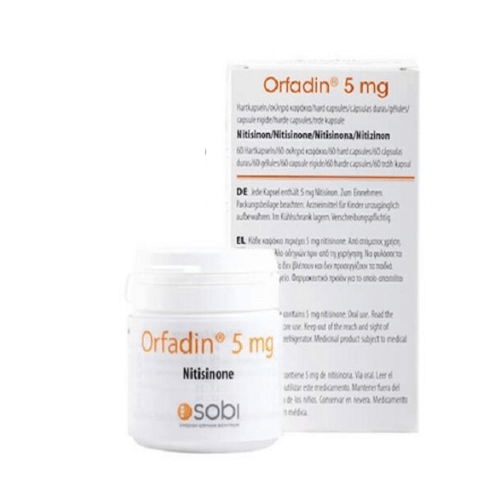
Step into the world of Orfadin, a revolutionary solution for rare genetic disorders such as hereditary tyrosinemia type 1 (HT-1). This medication tackles the complexities of HT-1 by addressing metabolic imbalances and easing debilitating symptoms. Discover the transformative power of Orfadin, offering hope to those navigating the challenges of rare diseases.
What Is Hereditary Tyrosinemia Type 1
HT-1, an autosomal recessive disorder, stems from mutations in the fumarylacetoacetate hydrolase (FAH) gene, which encodes the enzyme responsible for breaking down tyrosine. This genetic defect leads to an accumulation of tyrosine and its metabolites, including fumarylacetoacetate (FA), in the liver and other tissues.
Symptoms of HT-1 can vary in severity and may not manifest until infancy or early childhood. Some of the most common symptoms include:
- Vomiting
- Diarrhea
- Abdominal pain
- Jaundice (yellowing of the skin and eyes)
- Liver failure
- Kidney problems
- Neurological issues, including seizures and developmental delays
About Orfadin
Orfadin (nitisinone) represents a significant breakthrough in the treatment of HT-1. By reducing FA levels, Orfadin helps to prevent liver failure, kidney problems, and neurological complications associated with HT-1.
FDA Approval and a Ray of Hope
In 1994, the FDA granted Orfadin orphan drug designation, recognizing its potential to provide a safe and effective treatment for HT-1. Subsequent clinical trials demonstrated Orfadin’s remarkable efficacy in improving liver function, preventing kidney problems, and slowing disease progression in HT-1 patients.
Mechanism of Action:
Orfadin works by inhibiting the enzyme 4-hydroxyphenylpyruvate dioxygenase (HPD), which is involved in the production of FA. By blocking this enzyme, Orfadin prevents the formation of FA, thereby reducing its accumulation in the liver and other tissues. This metabolic intervention helps to restore balance and alleviate the harmful effects of HT-1.
Precautions, Warnings, and Contraindications
Prior to initiating the medication, inform your healthcare provider about any allergies to other medications, foods, preservatives, or dyes. Additionally, share details about your dietary habits with your doctor. Your healthcare professional will guide you on adhering to a diet that limits tyrosine and phenylalanine content.
- Increased Tyrosine Levels, Ocular Manifestations, Developmental Impairment, and Hyperkeratotic Lesions: Insufficient control of tyrosine and phenylalanine intake may result in heightened plasma tyrosine, leading to symptoms, developmental delay, or hyperkeratotic lesions. Refrain from modifying Orfadin dosage to decrease plasma tyrosine; uphold levels below 500 micromol/L. Conduct slit-lamp examination before initiating treatment and re-evaluate in case of symptom occurrence. Evaluate plasma tyrosine in instances of sudden neurological alterations.
- Leukopenia and Profound Thrombocytopenia: Routinely monitor platelet and white blood cell counts throughout Orfadin therapy.
- Potential Adverse Effects Due to Glycerol Content in Orfadin Oral Suspension: Consumption of doses exceeding 20 mL of Orfadin oral suspension may elicit unfavorable responses such as headache, gastrointestinal discomfort, and diarrhea attributed to glycerol content. Contemplate transitioning patients to Orfadin capsules.
Avoid taking Orfadin if you are allergic to any medication containing nitisinone or any ingredients listed at the end of this leaflet. Allergic reactions may present with symptoms like shortness of breath, wheezing, difficulty breathing, swelling of the face, lips, tongue, or other body parts, and skin reactions such as rash, itching, or hives. If you experience any of these signs, seek medical attention promptly.
Dosage and Administration:
The initial recommended dose of Orfadin is 0.5 mg/kg orally twice daily, with subsequent titration based on biochemical and/or clinical response, as detailed in the complete prescribing information. The maximum dosage is 1 mg/kg orally twice daily.
Regarding administration, follow the full prescribing information for guidance on preparing, measuring, and administering the oral suspension. Maintain dietary restrictions of tyrosine and phenylalanine.
Take Orfadin capsules at least one hour before or two hours after a meal. For patients having difficulty swallowing capsules and those intolerant to the oral suspension, the capsules can be opened and the contents suspended in a small amount of water, formula, or applesauce immediately before use. Orfadin oral suspension can be taken without regard to meals.
Drug Interactions:
Inform your healthcare provider or pharmacist about all medications you are using, including those obtained without a prescription from your pharmacy, supermarket, or health food shop. Some drugs may interact with Orfadin, potentially impacting their effectiveness. Examples of such medications are :
- Warfarin: Utilized for blood thinning.
- Phenytoin: Prescribed for epilepsy treatment.
- Furosemide (Frusemide): A diuretic.
The interaction between these medicines and Orfadin may necessitate adjustments in dosage or the need for alternative medications. For comprehensive information on medications that require caution or avoidance while taking Orfadin, consult your doctor and pharmacist.
Pregnancy and Breastfeeding:
- Orfadin should be used with caution in pregnant or breastfeeding women. Inform your doctor about your pregnancy, plans to conceive, or if you are currently breastfeeding. Your healthcare provider will engage in a discussion with you regarding the potential risks and benefits involved.
- The available data on the use of Orfadin in pregnant women is limited and insufficient to determine any associated drug risks. Notably, there is a lack of information on the presence of Orfadin in human milk, its impact on the breastfed infant, or its effects on milk production. It is advised not to breastfeed during Orfadin treatment.
- Additionally, it’s worth mentioning that clinical studies on Orfadin did not encompass subjects aged 65 and over.
It is important to discuss the risks and benefits of Orfadin therapy with a healthcare provider before making a decision.
Availability Of Orfadin/How to buy Orfadin online?
Acquiring Orfadin online has been streamlined for your convenience. To access this medication, exclusive to the US and Europe, you can contact the SANSFRO team or other experienced firms specializing in importing medicines from these regions.
For precise nitisinone price information, connect with our dedicated Patient Support Team at (+91) 9315705373 or email help@sansfro.com. Our team ensures accurate and current cost details for orfadin in the Indian market after Import.
Conclusion:
Orfadin has revolutionized HT-1 treatment, offering an impactful therapy that addresses metabolic imbalances and improves quality of life. Its proven efficacy and safety establish it as a key component in HT-1 management, serving as a guiding force for affected individuals. For questions about Orfadin, consult your doctor.
Reference:



